
The Definitive Guide to Bed Fishing – Part III
Published April 12, 2010 by Kevin Scarselli- Part 1: Where To Find Beds
- Part 2: Tricks For Seeing Underwater
- Part 3: What To Look For When Scanning For Bass and Beds
- Part 4: Tactics For Catching Bedding Bass
Part 3: What To Look For When Scanning For Bass And Beds
Nothing is more important than knowing what to look for when scanning for bass and beds.
Most anglers get this all wrong.
Most amateur bed fishermen think the key to effective spotting is scanning the water for shapes. In other words, they know what shape a bass is and they start looking for things that match that “fish shape”.
Or worse, they focus their scanning on finding “movement”. They are looking for a waving tail, a fanning fin, or something like that.
While these certainly CAN alert you to a fish’s presence, these should NOT be the primary points of your search. There are far more effective things to look for…
The Things That Make Bass Easy To Spot
Again, it is not shape and it is not movement. There are 5 things that clue you into a largemouth’s presence better than any other, they are…
- Color
(Bass are green. With good sunglasses, you can spot something green easily and quickly)
- Dark Caudal/Tail Fin
(Most bass have a darkened end to their caudal/tail fin that is slightly forked)
- Lateral Line
(Some bass have a very strong and visible lateral line. Others’ are hardly visible at all)
- Eye
(The eye is a great ‘positive confirmation’ aid)
- Lips
(The lips are usually brighter and can help positively confirm a fish)
While color is a fairly obvious thing to scan for, you may be wondering how such small features like dark tail fins and lateral lines can be so important for spotting bass. Below is a set of photos shot with a polarized lens. It is of the same bass who was sitting motionless.
In each progressive photo, I have digitally removed each of the numbered features above to show you how little importance “shape” has, and how great of importance these smaller features have in spotting fish…
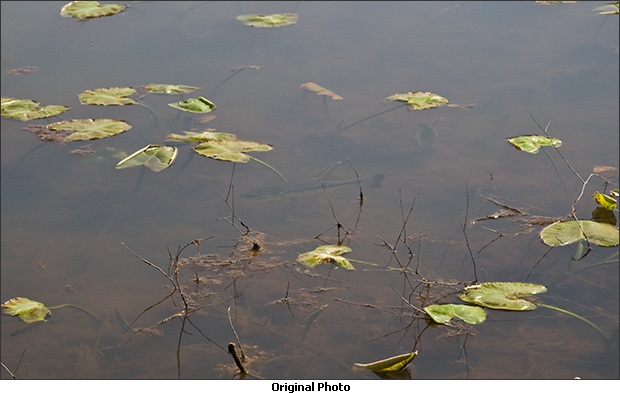
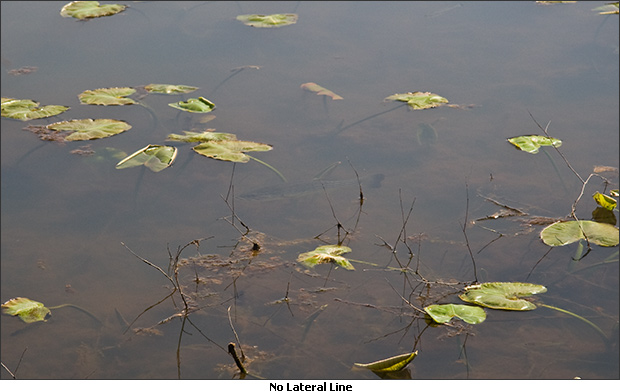
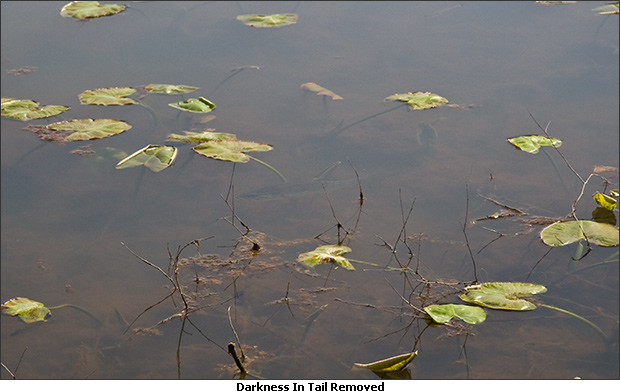
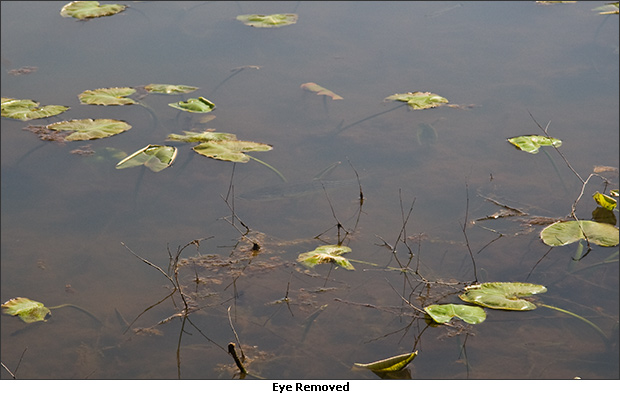
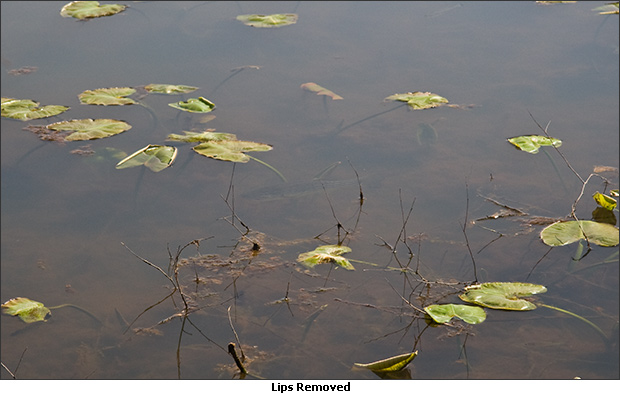
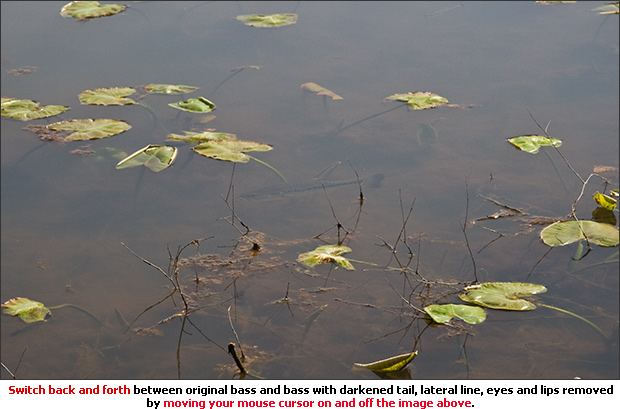
Comparing the photo of the bass with the lateral line, dark fin, eyes and lips removed to the original photo, it is very apparent that fish “shape” would play a very small role in the quick spotting of this particular fish. Without these features on the fish, you could easily miss this fish during your scanning.
Using The Eye and Lips For Positive Confirmation
I want to show you another example of how important using eyes and lips are for positive identification.
And let me make it clear… you don’t start your scan looking for eyes and lips. While you do start your scan looking for color, dark caudal fins and lateral lines, you only use eyes and lips when you spot something that “could be a bass”. When you spot something you are unsure about, you then look for eyes and lips to get “positive confirmation” that it is indeed a bass (and not an underwater weed or piece of wood, etc).
Here is a photo of a bass from a distance where glare is playing a role. You will also notice the bass’ caudal fin is blocked by a lily pad stem. This is a very difficult spot, but one that happens frequently. You could easily confuse this bass with an underwater lily pad…
But because you know to look for eyes and lips, this bass instantly becomes “positively confirmed” and you can begin fishing it.
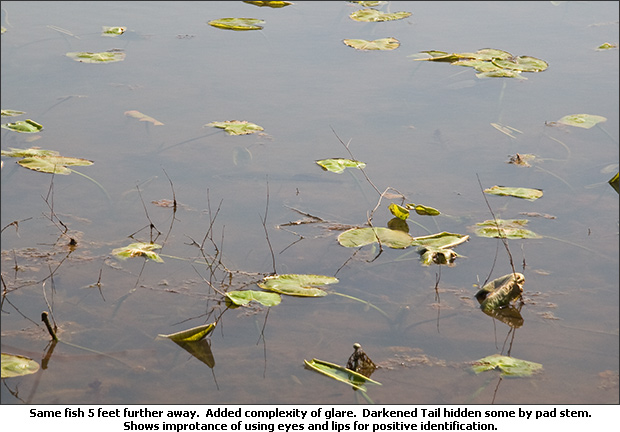
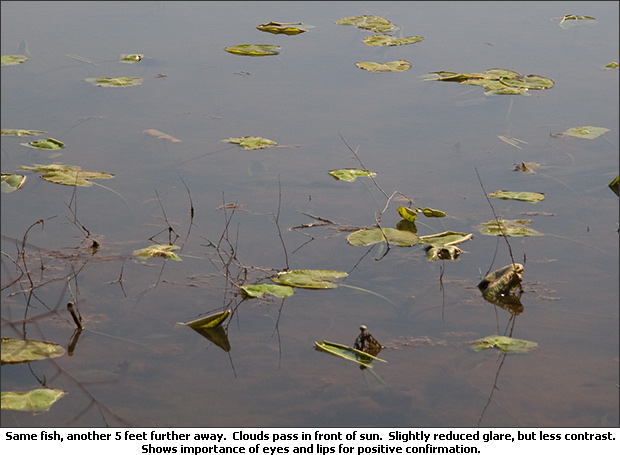
Notice above the very small darkened dot where the eye is, and even more visible, the lightened lips of the bass. You can even notice a slight lateral line. Without these features, I dare to say, 99% of bed fishermen would scan right over this fish. But a good bed fishermen, knowing what to look for and what to use for confirmation, would have a decent chance of spotting this bass.
The Most Important Thing To Look For: Green Color
Unfortunately in most of the photos here, I had to use a gray polarized lens which does not amplify greens. So I really don’t have any visual evidence to prove the importance of “looking for green”. But please know polarized sunglasses with copper, amber and bronze lenses help make bass standout by amplifying the green wavelengths of light.
Looking for “green” when scanning for bass is much easier than looking for shapes. Lake floors are littered with rocks, stumps, shadows, pebbles, branches.. you name it. You really stand no chance trying to identify a particular shape amongst thousands of other shapes. It becomes a “Where’s Waldo” type thing that is far less effective.
With a good pair of colored lenses, you can scan quickly for color. Most lake bottoms in spawning habitats are sand or gravel colored, making it easy to find “green spots” amongst consistent sand or gray bottoms.
Place more emphasis on color than on shape and you’ll take a monstrous leap to better bass spotting.
Dark Caudal (Tail) Fins
Most bass have a darkened end to their caudal (tail) fin. This fin goes from a light translucent green to a dark black underwater.
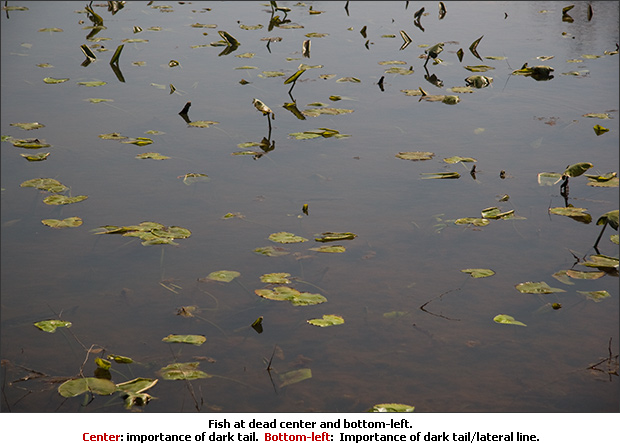
When I come across a greenish color, or spot something that I think might be a bass, a darkened caudal fin is the first thing I look for for positive confirmation.
Also notice the slight fork in the tail. This fork is also a dead giveaway that what you see is a bass. But please know, many similarly shaped fish have forked tails… most notably carp. But carp have a much more pronounced forked tail and this pronounced fork is exactly the tell-tale sign that what you see is a carp. Bass will never have a very pronounced fork in their caudal fin.
Here are some examples of how important the darkened caudal fin is to spotting bass…
In this photo, you can easily see a bass in the lower-left side of the frame. The initial giveaway is the darkened caudal fin.
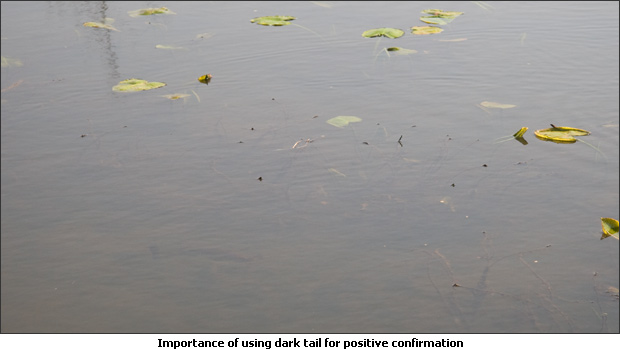
To prove how important that caudal fin was to spotting this fish, I have digitally removed the dark caudal fin so you can see how difficult it would be to spot this fish without it. And remember, you already know there is a fish there, but try to imagine how hard it would be if you had no clue a fish was even in the area.
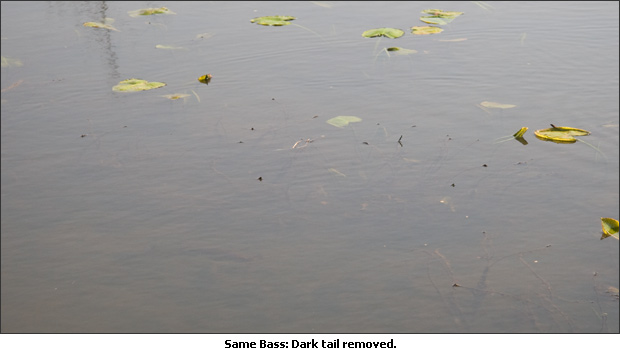
Lateral Line
The lateral line can be an important visual cue in spotting bass and is something you always need to be looking for. These often straight and dark lines are dead giveaways, especially amongst weeds, grass and other stems that grow vertically.
But some bass don’t have a very visible lateral line, so just know the absence of a lateral line shouldn’t be grounds for negative confirmation.
The Truth About Movement
I don’t want to sound like you should completely ignore movement, because it is one of the easiest things to confirm. But you should never be “looking” for movement.
If you tell your brain to look for movement, your brain will not focus as much on non-moving things. And when it comes to bass on beds, they don’t move very much.
Many anglers speak of scanning for waving pectoral fins. I bet 95% of the time such anglers will spot a particular bass with moving fins due to other features (green color, dark fin, lateral line, etc) and then use the waving pectoral fins as positive confirmation. Because the moving fin is such a huge positive confirmation, they tend to immediately forget what brought their eyes to that fish initially. I would hallucinate it is rarely because of a waving pectoral fin.
As humans, our brains seek out what we tell it to. Tell it to seek out the most identifiable cues first, and use the less identifiable cues for confirmation purposes.
Experience: Seeing Something From Next To Nothing
If you begin using the tips and techniques we’ve outlined above for spotting bass, you will be one of the best bass spotters in your region. The vast majority of anglers are still looking for “shape” and “movement”. Toss these away and you’ll discover an entire of world of bass living right before your very eyes… ones that you never noticed before.
But even armed with this powerful information, spotting some fish will be incredibly difficult. This is where experience begins playing a major role.
In the following photos, I want to show you how easy it is to “not see” bass. Often as anglers, we spot one bass easily and become so fixated on it, that we forget, or become unable, to spot any other fish in its immediate surroundings.
In the center-bottom of the next photo, you will spot a small bass.
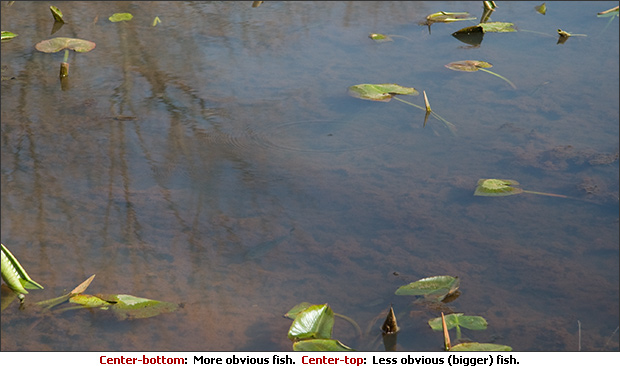
But there is a bigger bass lurking nearby. See it? Most probably will not see it.
Zooming in a bit more, you probably will see it now…
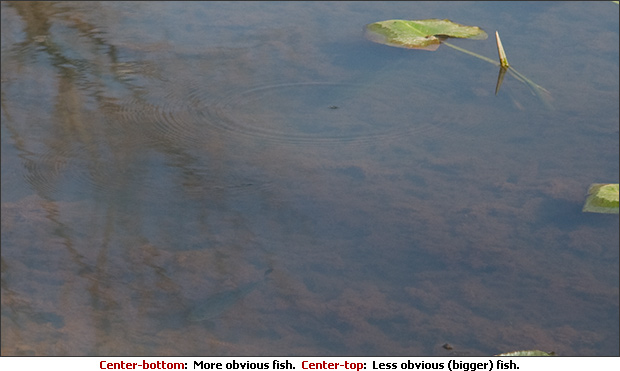
If still no, a bit more zoomed in on the less-obvious ‘bigger’ bass…
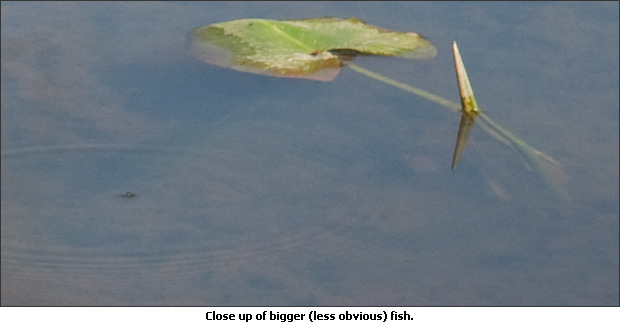
This proves that spotting bass isn’t easy, even when most of a particular fish is in view. The textures, shadows and make up of the bottom and surroundings can wreak havoc with your spotting.
Here is another example of a couple of bass…
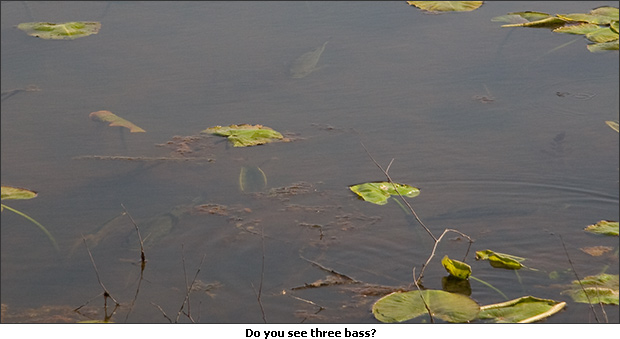
The most obvious is the center-top fish. You will also notice a bass in the lower-right, easily identified by the dark caudal fin and lateral line.
But there is an even bigger bass in this photo… do you see it?
If not, take a look in the lower-left and try to look for the eyes and lips as positive confirmation.
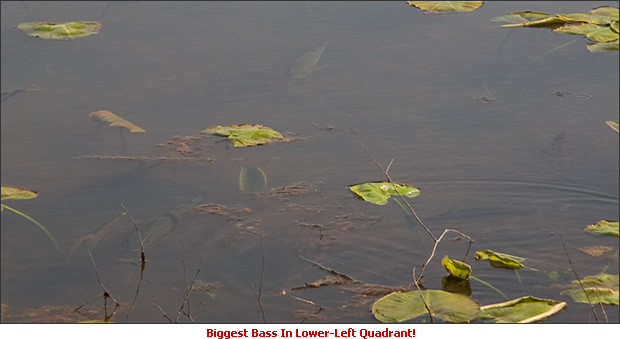
If you still don’t see the bass, keep looking, you will find it eventually.
Here is a classic example of having to spot bass through brush… a common scenario with laydown-heavy shorelines.
Can you spot the fish?
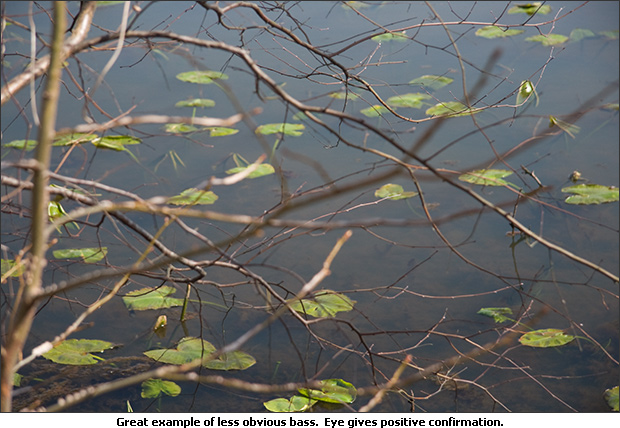
If not, here’s the hint. It is in the lower-right quadrant.
This is an extremely difficult spot, but for me, the very faint left-eye and the green color was the positive confirmation.
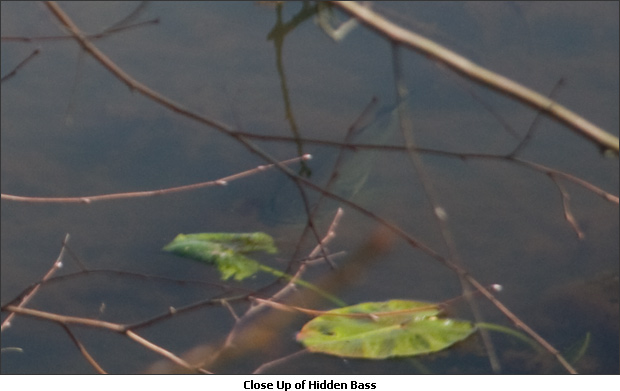
Spotting Beds
Spotting beds is much easier in comparison to spotting bass.
Beds are generally round and appear ‘brighter’ than the surrounding area. They are essentially round, bright spots on the lake bottom. Sometimes (but seldom) you may find a bed that is darker than the surrounding bottom. Generally the darker beds occur in deeper water.
Now some beds are invisible, in which case you’ll have to spot the bass first. This is a common occurrence and why you need to be looking for both bass and beds at the same time.
In Part 4 of The Definitive Guide To Bed Fishing, you will discover the little-known tactics for catching bedding bass…
- Part 1: Where To Find Beds
- Part 2: Tricks For Seeing Underwater
- Part 3: What To Look For When Scanning For Bass and Beds
- Part 4: Tactics For Catching Bedding Bass








